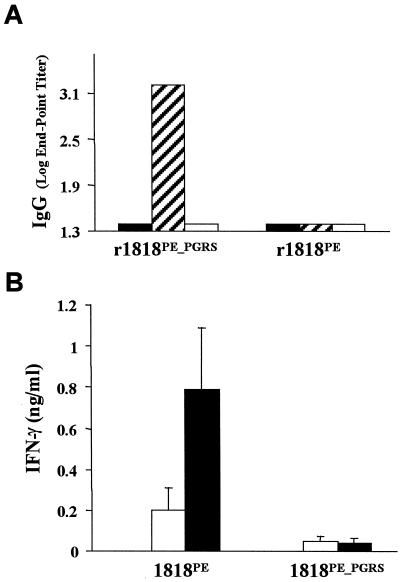FIG. 4.
Immunity to tuberculosis induced by DNA vaccines constructed from 1818PE_PGRS and 1818PE. Mice were immunized with endotoxin-free plasmid DNA purified as previously indicated (8). Groups of C57BL/6 mice were immunized intramuscularly in the hind limbs on days 1, 21, and 42 using 100 μg of plasmid DNA in a total volume of 0.1 ml. (A) The humoral response induced in mice vaccinated with vector only (solid bars), 1818PE_PGRS (hatched bars), or 1818PE (open bars) was analyzed by ELISA using sera from mice (five mice each) collected 30 days following the third DNA vaccination. Plates were coated with purified histidine-tagged recombinant proteins r1818PE_PGRS or r1818PE as indicated, and results are expressed as the IgG log10 endpoint titer. The dispersion around the mean value for the five mice, for each response was not significant. (B) Comparison of the IFN-γ response generated by immunization of mice with 1818cPE and 1818cPE_PGRS DNA vaccines and assessed by cytokine ELISA, following in vitro restimulation of splenocytes with activated macrophages. Murine BMMφ were infected with M. tuberculosis (solid bars) at an MOI of 5:1 or were primed with 1 μg of PPD (open bars) per ml 24 h prior to incubation with splenocytes obtained from vaccinated mice 30 days after the final immunization. Supernatants were collected 72 h later, and the amount of IFN-γ was measured using a cytokine-specific ELISA. The data represent the pooled response from five mice and show the standard deviation from the mean.

